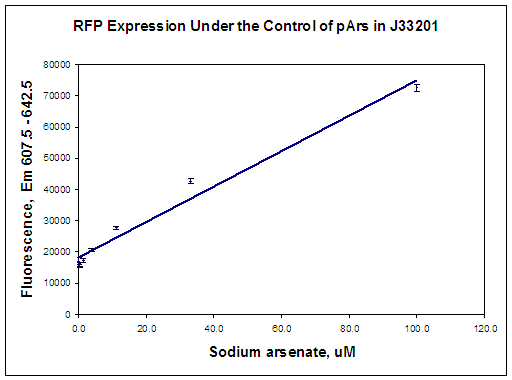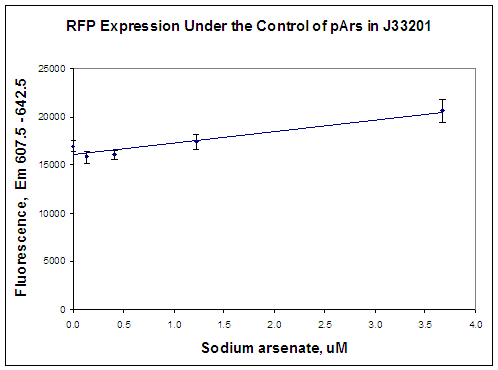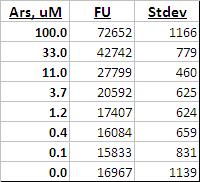Part:BBa_J33201:Experience
This experience page is provided so that any user may enter their experience using this part.
Please enter
how you used this part and how it worked out.
Applications of BBa_J33201
This part is designed for the detection of arsenic (as arsenate or arsenite) in drinking water. Various reporter genes can be attached to the part and will be induced in the presence of arsenate or arsenite.
User Reviews
UNIQc8be13b7da12abd0-partinfo-00000000-QINU
|
••
iGEM Edinburgh 2006 |
As part of IGEM 2006, the Edinburgh team attached this part to a lacZ' reporter gene and observed activity in the presence of arsenate. When lactose was included in the growth medium, lactose hydrolysis by LacZ, followed by lactose fermentation, resulted in a considerable pH drop in the presence of arsenate at concentrations as low as 5 ppb arsenic (0.067 micromolar). Effects typically required around 5 hours incubation in the presence of arsenate to become manifest, longer at arsenate concentrations below about 0.2 micromolar. In other work using xylE as a reporter gene, we have observed a similar time course, with around 5 hours induction required for an obervable increase in reporter gene activity. |
|
••
iGEM IvyTechSouthBendIN 2012 |
As part of IGEM 2012, the Ivy Tech Team loaded J33201 into the Endy Lab expression vector J61002 to compare relative promoter strengths by RFP expression. Briefly 8x10^7 Top Ten E.coli cells transformed with J33201 in J61002 were suspended in 200 uL of LB with increasing concentrations of sodium arsenic (from 0 to 100 uM) and incubated for 24 hrs, 37C. Fluorescence was measured at Em 625 (30) following Ex at 585 (20) on a Molecular Diagnostics FilterMax F3 machine. Sensitivity to added sodium arsenate was found to be about 3 uM. |
|
••
iGEM Gaston Day School 2012 We grew liquid cultures for 24 hours with varying concentrations of Cadmium Nitrate in the presence of our cells. After growth, the tests were spun down, then resuspended in 1X PBS (Phosphate Buffer Solution). We tested the detector with Cadmium since the promoter is responsive to multiple heavy metals. Due to safety issues, we were unable to use Arsenic because we are in BSL1 and it is a known poison. The results were measured in fluorescence per OD 600. The graph below shows our results.  |
|
•••
iGEM Worcester WPI |
As part of IGEM 2014, the Worcester WPI team worked to quantify the performance of this reporter through integration with the banana odor construct BBa_J45200. Although we noticed trends of increased expression in the presence of arsenite, there was some expression of the enzyme without arsenite. This leads us to believe that the repressor binds only weakly, or is unbound by more than just heavy metals. But in a general trend, expression did increase significantly up to 5uM arsenite. |
UNIQc8be13b7da12abd0-partinfo-00000005-QINU



